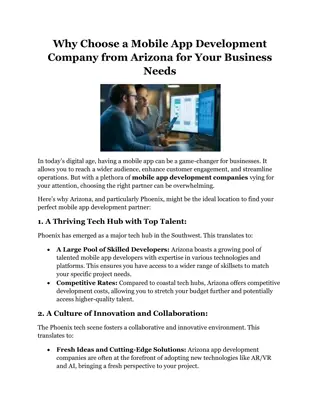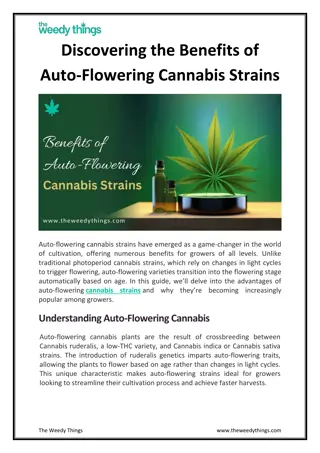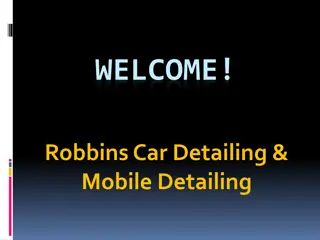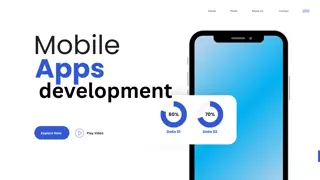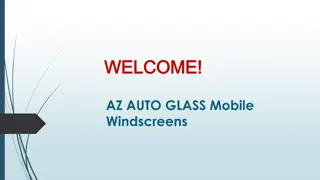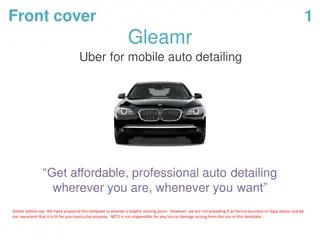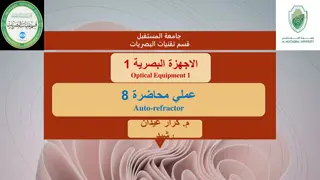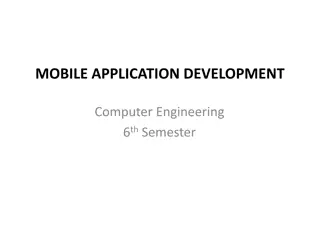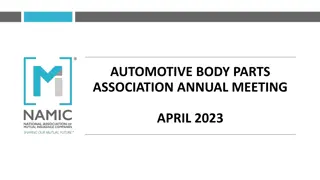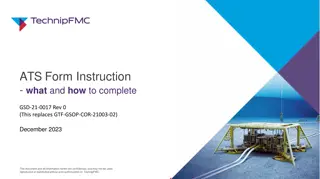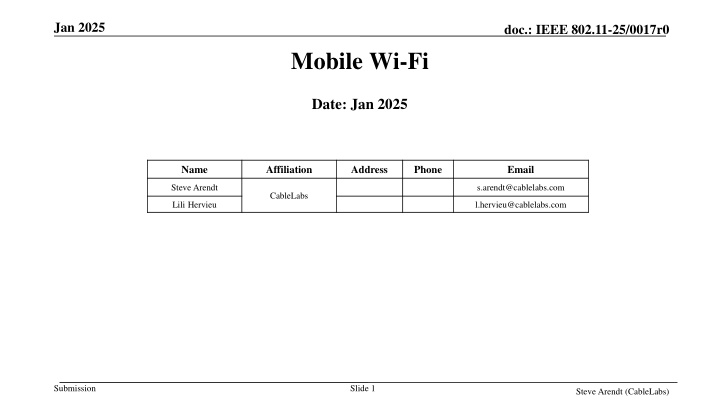
Innovations in Mobile Wi-Fi Technology Explained
Uncover the advancements in Mobile Wi-Fi technology with insights on AP-AP roaming solutions, challenges in Wi-Fi connectivity, and the evolution of roaming standards like IEEE 802.11r/k/v/u. Discover how Mobile Wi-Fi tackles the issues of sticky clients and sub-optimal band selections, offering a potential solution to improve user experience and network efficiency in the evolving landscape of wireless connectivity.
Uploaded on | 0 Views
Download Presentation

Please find below an Image/Link to download the presentation.
The content on the website is provided AS IS for your information and personal use only. It may not be sold, licensed, or shared on other websites without obtaining consent from the author. If you encounter any issues during the download, it is possible that the publisher has removed the file from their server.
You are allowed to download the files provided on this website for personal or commercial use, subject to the condition that they are used lawfully. All files are the property of their respective owners.
The content on the website is provided AS IS for your information and personal use only. It may not be sold, licensed, or shared on other websites without obtaining consent from the author.
E N D
Presentation Transcript
Jan 2025 doc.: IEEE 802.11-25/0017r0 Mobile Wi-Fi Date: Jan 2025 Authors: Name Affiliation Address Phone Email Steve Arendt s.arendt@cablelabs.com CableLabs Lili Hervieu l.hervieu@cablelabs.com Submission Slide 1 Steve Arendt (CableLabs)
Jan 2025 doc.: IEEE 802.11-25/0017r0 Introduction What is Mobile Wi-Fi? A way to do AP-AP roaming without breaking the current Wi-Fi session. 1. 2. 3. Submission Slide 2 Steve Arendt (CableLabs)
Jan 2025 doc.: IEEE 802.11-25/0017r0 Same AP-AP Roaming Can Work For Vehicles 1. 2. 3. Submission Slide 3 Steve Arendt (CableLabs)
Jan 2025 doc.: IEEE 802.11-25/0017r0 Don t We Already Have AP-AP Roaming? Sticky Client : Client stays associated to an AP even if better AP available Other Roaming issues: Edge of Coverage : Client stays connected to Wi-Fi even if signal strength is too low and there is a cellular network available Sub-Optimal Band : Client stays on a particular band even when there is a more appropriate band available (e.g. 2.4 when should be on 5, or vice versa) Submission Slide 4 Steve Arendt (CableLabs)
Jan 2025 doc.: IEEE 802.11-25/0017r0 This Is Not A New Problem Many attempts to improve roaming over 10+ years 802.11r (2008) Fast BSS Transition Shorten the time to re-authenticate when moving AP 802.11k (2008) Radio Resource Measurement Assisted Roaming Neighbor report to help choose next AP based on RSSI and load 802.11v (2011) BSS Transition Unsolicited/Solicited roaming request 802.11ai (2016) Fast Initial Link Setup 802.11u (2011) Automatic discovery of networks (HotSpot 2.0/Vantage) Vantage/Agile Multiband 802.11r/k/v/u Vantage/Optimized Connectivity 802.11k/ai 802.11 bn (coming) None of these fix the underlying problem: The phone struggles to maintain optimal Wi-Fi connection, and functionality varies by phone. Submission Slide 5 Steve Arendt (CableLabs)
Jan 2025 doc.: IEEE 802.11-25/0017r0 What s the Real Problem? Clients are responsible for choosing when to go to another AP or band and often don t do a good job of Wi-Fi roaming. Clients often stick with what they know Connectivity is good enough , don t risk switching (reassociation delay/failure = risk) Stay with what they know don t risk changing Clients may not have full visibility into network Phones often stick to using Wi-Fi over cellular, even when Wi-Fi is the worst choice (very low throughput) Consumer has bad experience: unresponsive phone -> turn Wi-Fi off Submission Slide 6 Steve Arendt (CableLabs)
Jan 2025 doc.: IEEE 802.11-25/0017r0 Mobile Wi-Fi / vBSS Technology Converts APs into a managed, virtualized Wi-Fi Radio Access Network (RAN) The client associates with its own virtualized BSS When a client moves, its virtualized BSS moves with it, no reassociation is needed No more need for client steering to try to force a client to roam Similar in spirit to cellular network Does not require any changes to client devices: no apps, no connection manager modifications, no VPNs Submission Slide 7 Steve Arendt (CableLabs)
Jan 2025 doc.: IEEE 802.11-25/0017r0 Controller VBSS (Assoc. Context) AP2 AP1 Radio 1 Radio 2 Radio 1 Radio 2 Normal BSS BSS BSS Normal BSS BSS BSS VBSS (Assoc. Context) Context) VBSS (Assoc. VBSS (Assoc. Context) Normal BSS BSS BSS Normal Normal Normal BSS BSS BSS Normal Normal Normal Normal Normal Normal Mobile Client Submission Slide 8 Steve Arendt (CableLabs) 8
Jan 2025 doc.: IEEE 802.11-25/0017r0 Example Throughput Throughput Mobile Wi-Fi Throughput Traditional AP1 AP2 Bad Wi-Fi Position Submission Slide 9 Steve Arendt (CableLabs)
Jan 2025 doc.: IEEE 802.11-25/0017r0 How Well Does It Work? Actual High-End Phone with Mobile Wi-Fi Actual High-End Phone without Mobile Wi-Fi RSSI to Red and YellowAPs NO Drop in throughput Drop in throughput Submission Slide 10 Steve Arendt (CableLabs)
Jan 2025 doc.: IEEE 802.11-25/0017r0 Current State of Project Concept developed and prototyped at CableLabs -- 2018 WFA EasyMesh R5 spec contribution for Mobile Wi-Fi submitted, approved, and released (2021 - 2022). Mobile Wi-Fi implemented in prplMesh open-source EasyMesh codebase (2022- 2023). Currently working on RDK-B implementation (2024) RDK-B is an open-source software platform that standardizes core functions used in broadband home network devices. Submission Slide 11 Steve Arendt (CableLabs)
Jan 2025 doc.: IEEE 802.11-25/0017r0 Automotive Possibilities Seamless Wi-Fi connectivity for vehicles via Community-wide Wi-Fi networks Municipal Wi-Fi networks Automotive-specific Wi-Fi networks Campus Wi-Fi networks Automotive users: Service vehicle fleets Delivery vans Public transit Submission Slide 12 Steve Arendt (CableLabs)






